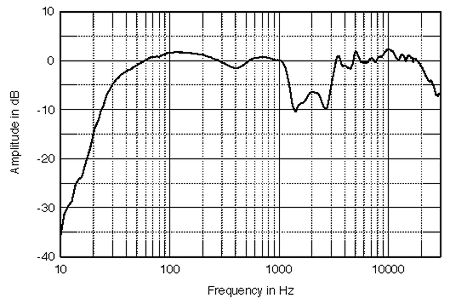| Columns Retired Columns & Blogs |
Totem Acoustic Tabù loudspeaker Measurements
Sidebar 3: Measurements
As Larry described, the Tabù is not very sensitive, 2.83V raising only 83.5dB at 1m—just 1dB more than the chronically insensitive LS3/5a. In addition, the speaker's impedance (fig.1) drops below 6 ohms below 2kHz, bottoming out at 3.34 ohms at 170Hz. This is a speaker that needs to see a lot of volts and a lot of amps to play at acceptable volumes. Note the unusual shape of the impedance trace: The speaker looks like a small inductor above the lower midrange. The small saddle in the magnitude trace at 30Hz indicates the tuning of the port.

Fig.1 Totem Tabù, electrical impedance (solid) and phase (dashed) (2 ohms/vertical div.).
Fig.2 shows the individual responses of the tweeter, woofer, and port, measured on the tweeter axis. The latter's output is the bandpass curve centered on its 30Hz tuning frequency, coincident with the woofer's minimum-motion point. But note the two resonant modes in the port's output, at 375Hz and 600Hz. The latter, in particular, could be heard behind the speaker as a distinct tone added to pink noise. It is a good thing that the port faces to the speaker's rear, because this would otherwise add coloration.

Fig.2 Totem Tabù, acoustic crossover on tweeter axis at 50", corrected for microphone response, with nearfield woofer and port responses plotted below 300Hz and 800Hz, respectively.
The rather ragged trace in the center of fig.2 represents the woofer's output. It looks as though it is allowed to roll off naturally, without a low-pass filter. The tweeter comes in gradually, not reaching its full level until 4kHz.
Fig.3 shows how these outputs sum on the tweeter axis. What would otherwise be a smooth, flat curve is spoiled by a significant lack of energy in the crossover region. LG didn't remark on any hollowness or distant character in his auditioning notes, so I must assume that this suckout either doesn't sound as bad as it looks (hard to believe), or that the tweeter axis is not the axis on which LG did his auditioning (very possible). To investigate this, I measured the Tabù's response in 5° steps from 45° below the tweeter axis to 45° above. The result is shown in fig.4. The tweeter-axis suckout can be seen as the "hole" just to the left of center of the energy surface. It should be obvious from this graph that the hole fills in for a range of angles just above the tweeter—the cursor is on the 10°-above trace—meaning that the unconventional, capacitorless crossover tilts the speaker's main response lobe up above the HF axis.

Fig.3 Totem Tabù, anechoic response on tweeter axis at 50", averaged across 30° horizontal window and corrected for microphone response, with the complex sum of nearfield woofer and port responses plotted below 300Hz.

Fig.4 Totem Tabù, vertical response family at 50", normalized to response on tweeter axis, from back to front: differences in response 45°–5° above axis; reference response; differences in response 5°–45° below axis.
This was confirmed by a plot of the speaker's response 15° above the tweeter axis (fig.5). While the low treble is still ragged—perhaps correlating with LG's comments on the speaker's "analytic" character—the overall balance is now quite even. The Tabù should definitely be auditioned so that the listener can see the top of the speaker, implying the use of low stands. The 23.5" May Audio stands are definitely too tall unless you sit high and a long way away from the speaker. (I would suggest something between 12" and 18" tops.) Laterally (fig.6), the Totem's dispersion on the tweeter axis is relatively even, apart from some flare at the bottom of the tweeter's passband. Again, this might correlate with the analytical quality noted by LG.

Fig.5 Totem Tabù, anechoic response on optimum axis at 50", corrected for microphone response, with the complex sum of nearfield woofer and port responses plotted below 300Hz.

Fig.6 Totem Tabù, horizontal response family at 50", normalized to response on tweeter axis, from back to front: differences in response 90°–5° off-axis; reference response; differences in response 5°–90° off-axis.
The step response (fig.7) reveals the two drive-units to be connected with the same positive polarity. The cumulative spectral-decay plot (fig.8) looks quite alarming, with a couple of resonant modes obvious in the mid-treble, these presumably due to woofer cone breakup. To an extent, the subjective effect of these modes will be music-dependent, but they, too, will add to the speaker's analytic character.

Fig.7 Totem Tabù, step response on tweeter axis at 50" (5ms time window, 30kHz bandwidth).

Fig.8 Totem Tabù, cumulative spectral-decay plot at 50" (0.15ms risetime).
Finally, although much attention has been paid to damping the Tabù's enclosure, I could still find some resonant behavior. As well as a low-level mode at 460Hz, a more lively resonance at 363Hz could be found on all the panels. Fig.9, for example, shows a waterfall plot calculated from the output of a simple plastic-tape accelerometer fastened to the center of the side wall.

Fig.9 Totem Tabù, cumulative spectral-decay plot of accelerometer output fastened to side of enclosure. (MLS driving voltage to speaker, 7.55V; measurement bandwidth, 2kHz.)
All in all, I was disappointed by the Tabù's measurements, especially considering how well Totem's Mani-2 and Model 1 performed in the test lab.—John Atkinson
- Log in or register to post comments




































